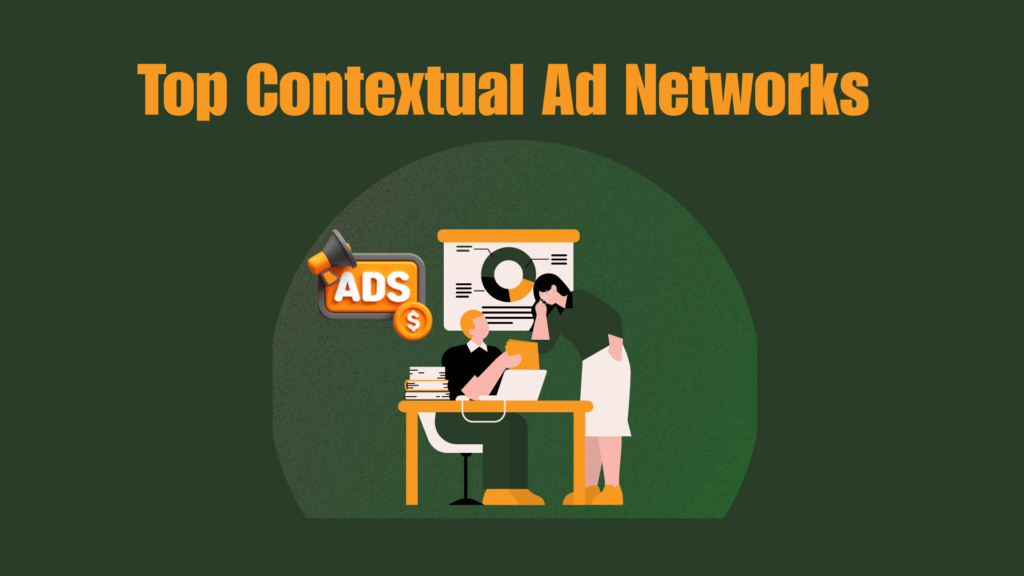The digital advertising landscape in 2026 is redefining how brands connect with audiences. With third-party cookies now phased out, advertisers and publishers are turning toward privacy-friendly solutions that maintain performance without compromising user trust. The spotlight is now on contextual ad networks — platforms that serve ads based on a page’s content rather than tracking user behavior.
Unlike traditional behavioral targeting, contextual advertising in 2026 leverages AI-driven keyword analysis, semantic understanding, and real-time relevance to match ads with on-page topics. This approach ensures compliance with global privacy standards while still delivering effective monetization for publishers.
For content creators, bloggers, and media owners, the shift to contextual advertising represents both a challenge and an opportunity. The challenge lies in adapting to new privacy rules and measurement models, while the opportunity lies in adopting smarter, transparent, and future-proof monetization strategies.
In this guide, we’ll explore the top contextual ad networks of 2026 that help publishers earn more — ethically and efficiently — in a world that prioritizes user privacy.
What Are Contextual Ad Networks?
Contextual ad networks are advertising platforms that display ads based on webpage content, not user data. They use semantic analysis, NLP, and keyword matching to target ads aligned with on-page topics. These networks don’t track users or rely on third-party cookies. Instead, they scan the visible text, metadata, and tags to determine relevance. Platforms like Media.net, GumGum, and SeedTag specialize in this privacy-first approach. Contextual targeting supports compliance with GDPR, CCPA, and other data privacy regulations. It ensures brand-safe placements by avoiding mismatched or unsafe content categories.
Why Should Publishers Choose Contextual Ad Networks?
Publishers should choose contextual ad networks because they enable privacy-compliant ad targeting without cookies. Contextual platforms like Media.net, GumGum, and SeedTag analyze page content using semantic AI, natural language processing, and visual recognition. This ensures high ad relevance without tracking users.
These networks improve CTR by aligning ads with content context, not behavior. Publishers benefit from faster page loads, GDPR/CCPA compliance, and user trust. Contextual targeting supports content-rich sites across news, lifestyle, and niche categories. It increases viewability, decreases bounce rates, and protects user privacy by avoiding identifiers.
Leading platforms also offer dynamic optimization, brand-safe placements, and higher fill rates for contextual impressions.
Why Contextual Advertising Networks Matter More Than Ever
Contextual advertising networks are essential in 2026 due to third-party cookie deprecation. These networks serve ads based on semantic page analysis, not behavioral profiling. Platforms like Media.net, SeedTag, and GumGum scan content in real-time to deliver privacy-first ads. EU and UK regulations GDPR, PECR, ICO mandate consent-free alternatives. Contextual targeting enables compliance, relevance, and brand safety. Oracle Contextual Intelligence data shows improved viewability and reduced ad fraud. Publishers gain higher CPMs, better UX, and legal assurance without personal data collection.
How to Choose the Best Contextual Ad Network
To choose the best contextual ad network:
- Ensure targeting uses NLP or AI-driven semantic matching, not basic keyword mapping.
- Verify compliance with GDPR, CCPA, and ICO standards.
- Confirm integration with Google Ad Manager, Prebid.js, or any custom CMS.
- Prefer networks with support for IAB taxonomy, real-time bidding (RTB), and dynamic ad rendering.
- Use trial data to test RPM, fill rate, latency, and ad load speed.
- Look for formats like in-image, in-article, native, interstitial, or outstream video.
- Check brand safety integrations like DoubleVerify, IAS, or MOAT.
Top providers like TripleLift, OpenWeb, and Sovrn meet most benchmarks for semantic accuracy, format diversity, and legal coverage.
Questions to Ask Before Choosing…
- Does the network use AI-powered semantic analysis for ad matching?
- Is the platform fully compliant with GDPR, CCPA, and other privacy laws?
- What targeting methods are used instead of third-party cookies?
- Can the network support real-time, page-level contextual targeting?
- Are brand safety and ad quality tools integrated into the platform?
- Does the network offer transparent reporting and performance metrics?
How This Top 10 List Was Created
To create this Top 10 Contextual Ad Networks list, we analyzed 2023–2026 adoption signals, platform usage data, and industry adaptation to cookie deprecation (source: Google Privacy Sandbox). Evaluation focused on semantic targeting, keyword-level relevance, and cookieless delivery without behavioral profiling.
We used SimilarWeb traffic rank, BuiltWith deployment data, and publisher usage to assess real-world traction. Platforms supporting GDPR, CCPA, and Privacy Sandbox APIs were prioritized. Popular ad tech ecosystems with native page-level targeting, IAB-compliant ad formats, and multi-vertical support received higher weight.
Final selections reflect contextual performance in live environments, verified integration support, and demand-side access. Each network included demonstrated compatibility with real-time ad delivery, semantic analysis, and privacy-preserving ad placement at scale.
Pricing Models in Contextual Advertising Networks
Contextual ad networks typically offer:
- CPM (Cost Per Mille): Pays per 1,000 impressions; used by Playwire, Media.net, and OpenWeb.
- CPC (Cost Per Click): Pays for actual user clicks; seen in performance-based platforms.
- Hybrid Pricing: Combines CPM and CPC; used by Sovrn, SeedTag, and TripleLift.
- Programmatic Bidding: Networks like Oracle, GumGum, and TripleLift integrate dynamic pricing via header bidding.
- Context Value Indexing: Oracle uses theme-match valuation for inventory scoring.
- Geo + Device Impact: Rates vary by region, screen type, and content vertical.
- Engagement Metrics: GumGum includes visual interaction scores in pricing logic.
Understanding these pricing layers helps match publisher goals to revenue potential across multiple content types and regions.
Top 10 Contextual Ad Networks That Respect Privacy in 2026
- Media.net – Best for contextual ads across premium content websites.
- GumGum – Best for in-image and rich media contextual targeting.
- Seedtag – Best for AI-powered visual contextual advertising.
- OpenWeb – Best for community-driven contextual ad placements.
- Oracle Contextual Intelligence – Best for brand-safe and semantic-based targeting.
- Playwire – Best for contextual monetization of niche and entertainment content.
- TripleLift – Best for seamless programmatic native ads with contextual alignment.
- Sovrn – Best for commerce-intent contextual targeting with content signals.
- Google Display Network – Best for scalable, keyword-targeted contextual reach.
- Criteo Contextual – Best for privacy-safe contextual ads in commerce and retail media.
#1. Media.net – Best for Contextual Ads on High-Quality Content Sites
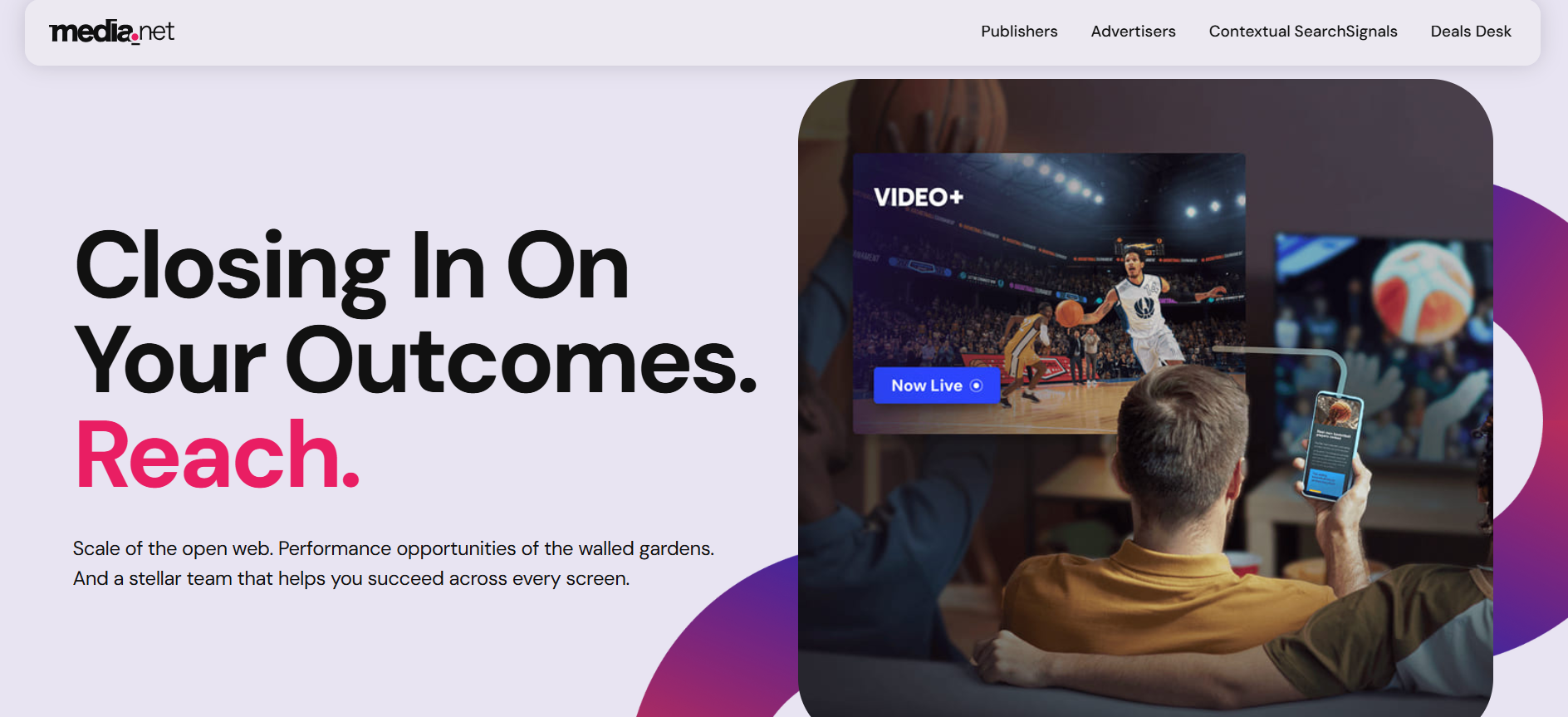
Media.net is a contextual ad network powering ads on Forbes, CNN, and Reuters. It uses machine learning to scan page content and serve non-personalized, highly relevant ads. As a Yahoo! Bing Network partner, it enables access to premium search and display demand. The platform supports display, native, and in-content ad units with real-time dynamic optimization. It’s built for brand-safe environments and performs well on evergreen, search-driven content. Media.net complies with GDPR and CCPA through cookie-free contextual targeting.
Features of Media.net:
- Page-level contextual targeting
- Display, native, and in-content formats
- Dynamic ad units with real-time optimization
- Yahoo! Bing Network integration
- Mobile responsive and AMP support
Reviews:
Publishers report strong RPMs and fast integration; however, results depend on niche relevance and traffic quality.
Privacy Compliance:
Follows GDPR and CCPA standards using non-personalized, cookie-free targeting methods.
Pros of Media.net:
- High-intent contextual targeting
- Yahoo! Bing Network access
- Trusted by premium publishers
Cons of Media.net:
- Requires quality content for approval
- RPM varies by niche and traffic
Final Verdict:
Media.net is ideal for content-rich sites seeking compliant, high-value contextual ads linked to search intent.
#2. GumGum – Best for Contextual Ads with Visual Intelligence
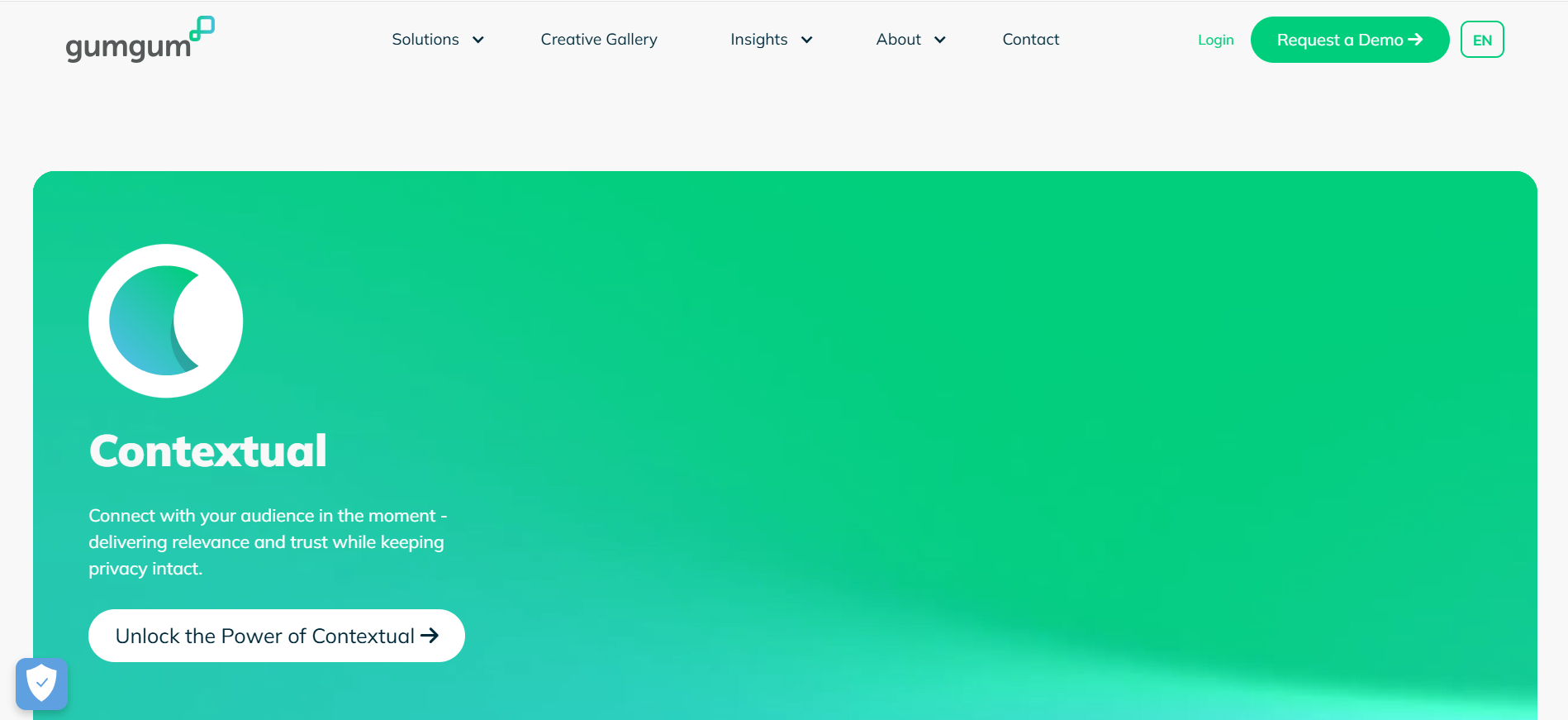 GumGum uses advanced image recognition and natural language processing to deliver highly targeted, privacy-friendly contextual ads. Its proprietary “Verity” platform scans text, images, and video to understand the full context of a page without using cookies or personal data. GumGum specializes in in-image, in-video, and rich media ads that blend seamlessly into visually rich environments like lifestyle, sports, or entertainment blogs.
GumGum uses advanced image recognition and natural language processing to deliver highly targeted, privacy-friendly contextual ads. Its proprietary “Verity” platform scans text, images, and video to understand the full context of a page without using cookies or personal data. GumGum specializes in in-image, in-video, and rich media ads that blend seamlessly into visually rich environments like lifestyle, sports, or entertainment blogs.
Features of GumGum:
- AI-powered contextual analysis (text + image)
- Verity™ contextual intelligence engine
- In-image, in-video, and rich media ad units
- Non-personalized, privacy-first targeting
- Suitable for visually-driven content sites
Reviews:
Publishers appreciate GumGum’s high engagement rates on media-rich content, especially on mobile, though setup may require collaboration with account managers.
Privacy Compliance:
Fully compliant with GDPR, CCPA, and other global standards using cookie-free contextual intelligence.
Pros of GumGum:
- Visual + textual content targeting
- Strong engagement on rich media
- No reliance on third-party cookies
Cons of GumGum:
- Works best with media-rich environments
- Initial setup can require technical assistance
Final Verdict:
GumGum is a go-to contextual ad solution for publishers with visual or video-heavy content who prioritize privacy and brand-safe placements.
#3. SeedTag – Best for AI-Powered Semantic Targeting
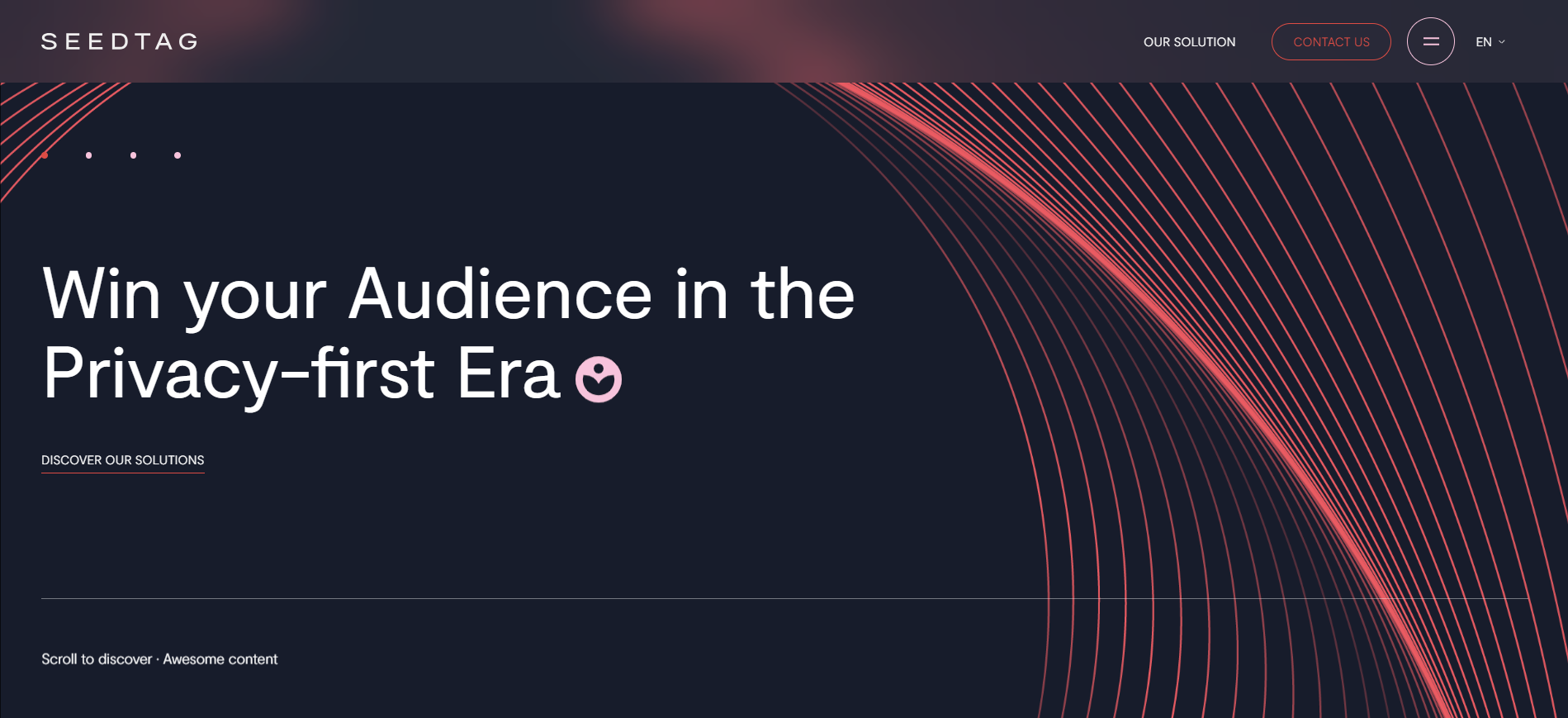
SeedTag delivers high-impact contextual advertising using its proprietary AI engine “Liz,” which semantically analyzes the entire content of a page—including text, images, and sentiment. This enables highly relevant ad placement without needing cookies or user data. SeedTag is trusted by global brands and publishers for premium, privacy-safe targeting across lifestyle, fashion, sports, and news websites.
Features of SeedTag:
- AI-based semantic content analysis
- Cookie-free contextual targeting
- In-image and native display formats
- Sentiment and brand safety scoring
- High-impact formats for premium publishers
Reviews:
Publishers highlight SeedTag’s ability to increase engagement and CPMs through non-intrusive yet visually engaging ads; however, premium partnerships are often required for access.
Privacy Compliance:
SeedTag is fully GDPR and ePrivacy compliant, focusing on non-personalized, AI-driven targeting.
Pros of SeedTag:
- Advanced semantic analysis
- High-performing ad formats
- Strong brand safety and sentiment analysis
Cons of SeedTag:
- Mostly available to premium publishers
- Requires well-structured content for best results
Final Verdict:
SeedTag is best suited for publishers looking for sophisticated, privacy-first contextual targeting that maximizes relevance and brand alignment.
#4. OpenWeb – Best for Contextual Ads in Community-Driven Environments
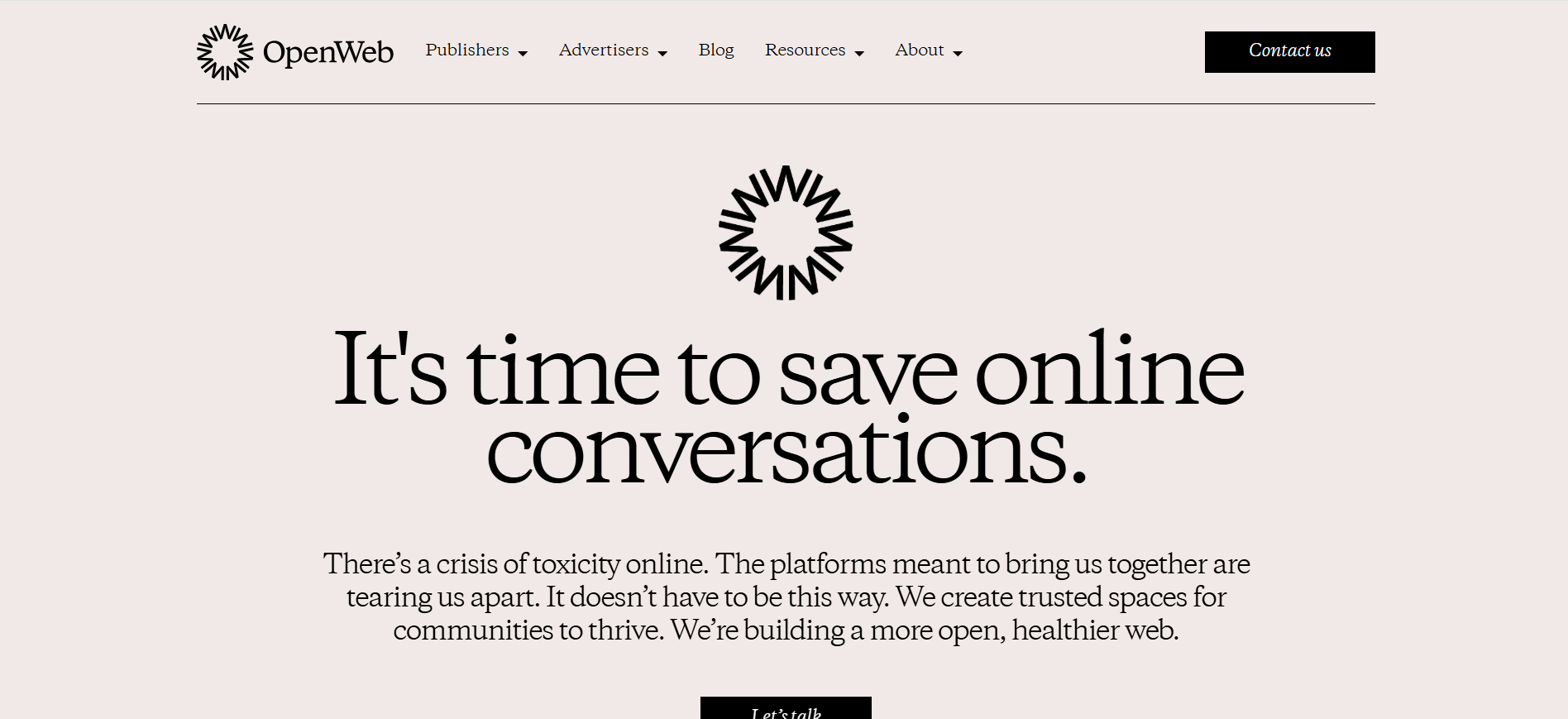
OpenWeb specializes in monetizing comment sections and community-driven content through contextual ads that align with on-page discussions. It leverages real-time NLP (Natural Language Processing) to scan conversation threads and place relevant, non-intrusive ads. OpenWeb is ideal for publishers fostering user engagement and seeking ad experiences that blend seamlessly into interactive content.
Features of OpenWeb:
- Contextual targeting within comment sections
- NLP-driven sentiment and topic analysis
- Native and in-feed ad placements
- Real-time engagement insights
- Scalable across large publishing networks
Reviews:
Publishers value OpenWeb for monetizing active user engagement zones and keeping ads contextually relevant. However, it’s most effective on sites with strong community interaction.
Privacy Compliance:
Compliant with GDPR, CCPA, and privacy-first standards by avoiding personal identifiers in targeting.
Pros of OpenWeb:
- Unique ad targeting based on conversations
- Drives monetization in high-engagement areas
- Seamless native integration
Cons of OpenWeb:
- Requires active comment sections
- Limited use for static content publishers
Final Verdict:
OpenWeb is ideal for publishers with vibrant comment communities, enabling privacy-friendly monetization tied to live user discussions.
#5. Oracle Contextual Intelligence – Best for Enterprise-Level Brand Safety and Precision
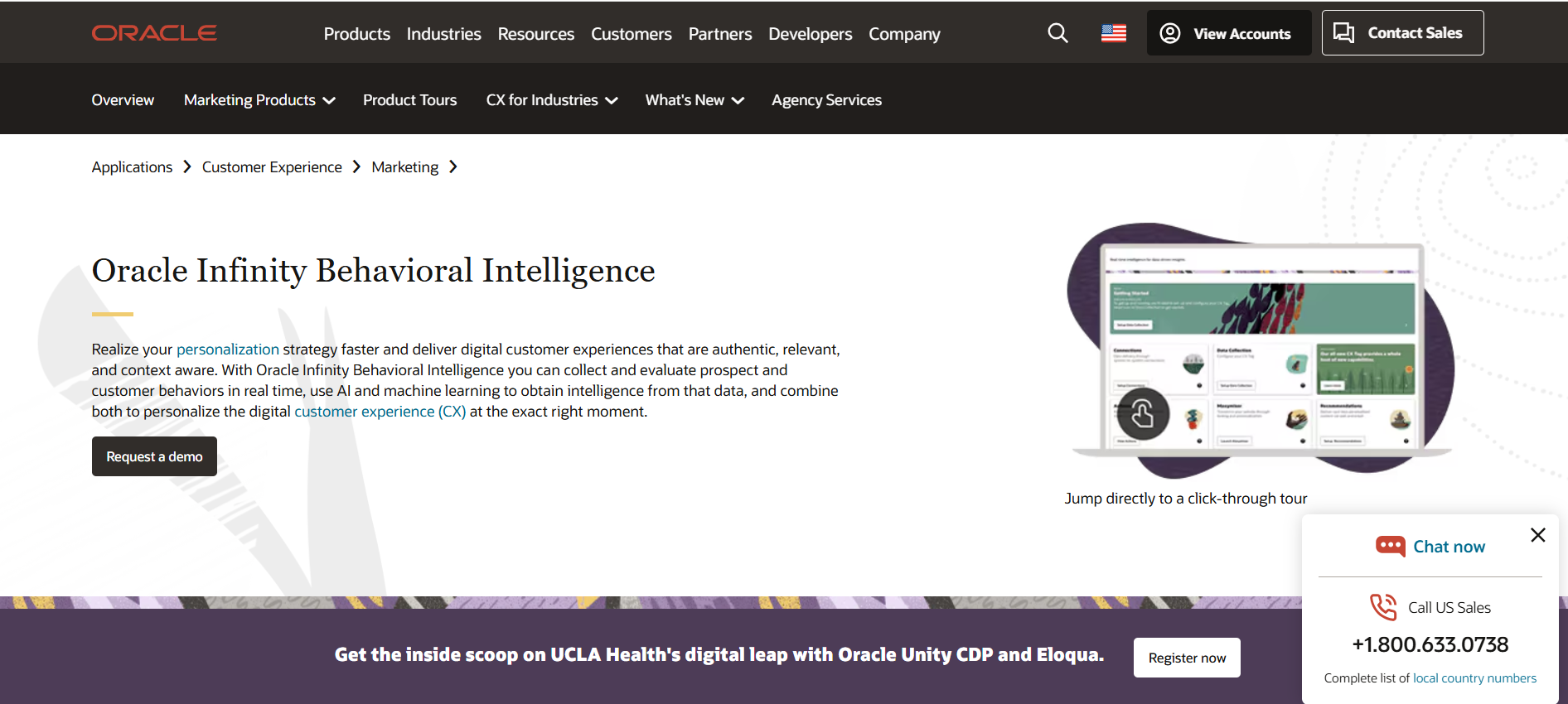
Oracle Contextual Intelligence is a leading solution for enterprise-grade advertisers and publishers seeking hyper-granular, privacy-first targeting. It uses advanced semantic analysis and natural language processing to classify page content without relying on cookies or user data. Oracle helps brands deliver ads that align with specific topics, sentiments, and safety standards across vast digital inventories.
Features of Oracle Contextual Intelligence:
- Semantic analysis with over 400,000 predefined categories
- Sentiment and brand safety filtering
- Language and regional content recognition
- DSP and SSP integration compatibility
- Real-time contextual insights and controls
Reviews:
Highly rated among agencies and premium publishers for delivering brand-safe, scalable contextual targeting. However, it’s more suitable for enterprise-scale operations with technical integration capabilities.
Privacy Compliance:
Fully compliant with GDPR, CCPA, and other global privacy regulations by avoiding personal data collection entirely.
Pros of Oracle Contextual Intelligence:
- Exceptional accuracy and scale
- Strong brand safety tools
- Works across multiple ad platforms
Cons of Oracle Contextual Intelligence:
- Complex setup for smaller publishers
- Requires technical knowledge or agency support
Final Verdict:
Oracle Contextual Intelligence is best suited for enterprises that demand highly customizable, safe, and regulation-compliant contextual targeting across global campaigns.
#6. Playwire – Best for Contextual Monetization of Media-Rich Content
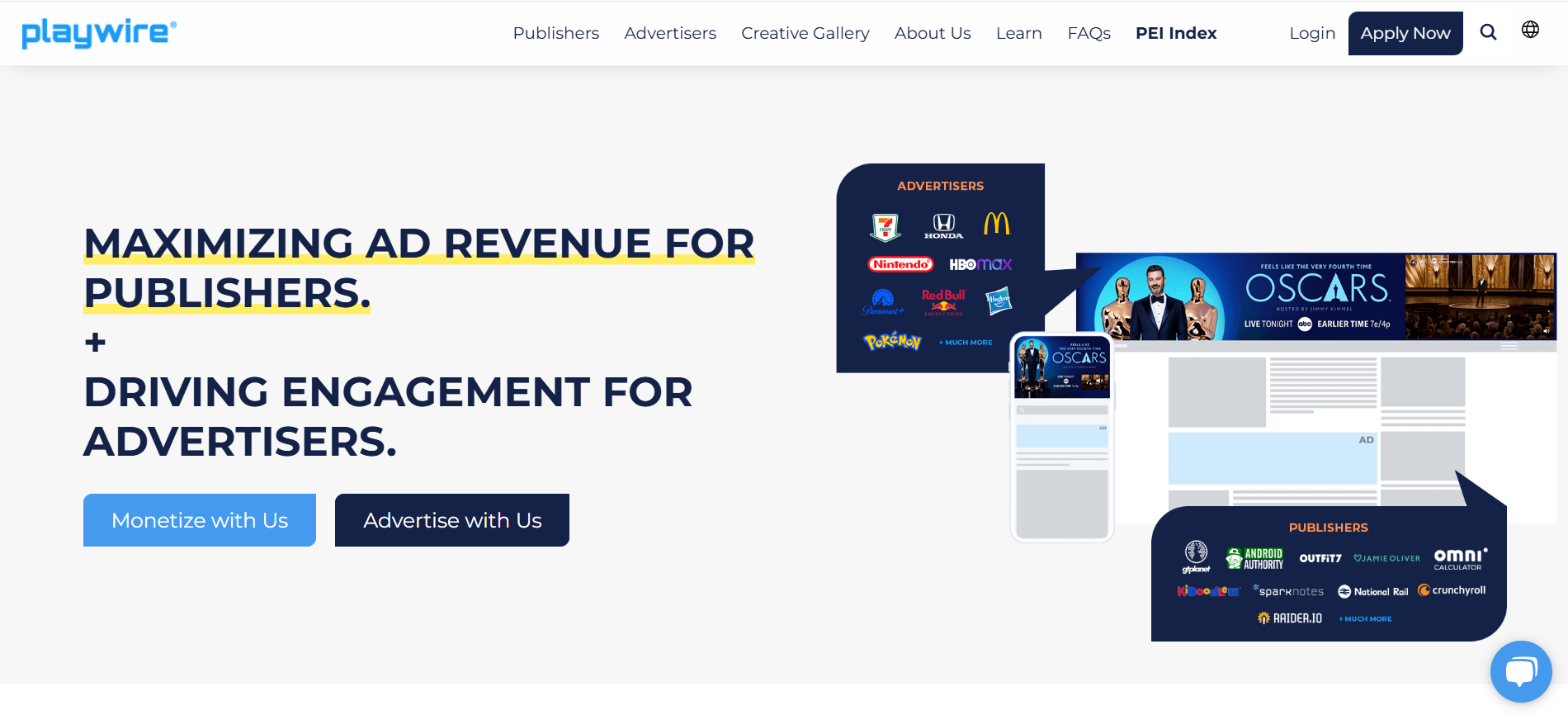
Playwire is a premium ad tech platform tailored for publishers with media-rich websites—such as gaming, kids, entertainment, and lifestyle content. It offers contextual targeting through proprietary RAMP® technology, combining machine learning and traffic segmentation to deliver high-performing, brand-safe ads without relying on cookies. Playwire manages all aspects of monetization, from demand sourcing to yield optimization.
Features of Playwire:
- RAMP® AI for contextual and behavioral ad optimization
- Full-stack ad management and monetization
- Direct demand partnerships and premium programmatic access
- High-impact ad formats for video, display, and interactive units
- Real-time reporting and revenue analytics
Reviews:
Publishers appreciate Playwire’s hands-off monetization and strong fill rates, especially for visually engaging sites. However, some report strict entry requirements and revenue-sharing models.
Privacy Compliance:
Complies with global data protection laws including GDPR and CCPA, using cookie-free contextual capabilities and publisher-consent tools.
Pros of Playwire:
- All-in-one monetization and optimization
- High-quality demand sources
- Strong for video and game content
Cons of Playwire:
- Entry-level traffic requirements
- Revenue split may reduce total earnings for smaller sites
Final Verdict:
Playwire is ideal for publishers running content-heavy or interactive media sites looking for full-service, privacy-compliant contextual ad monetization.
#7. TripleLift – Best for Contextual Native Ads with Programmatic Efficiency
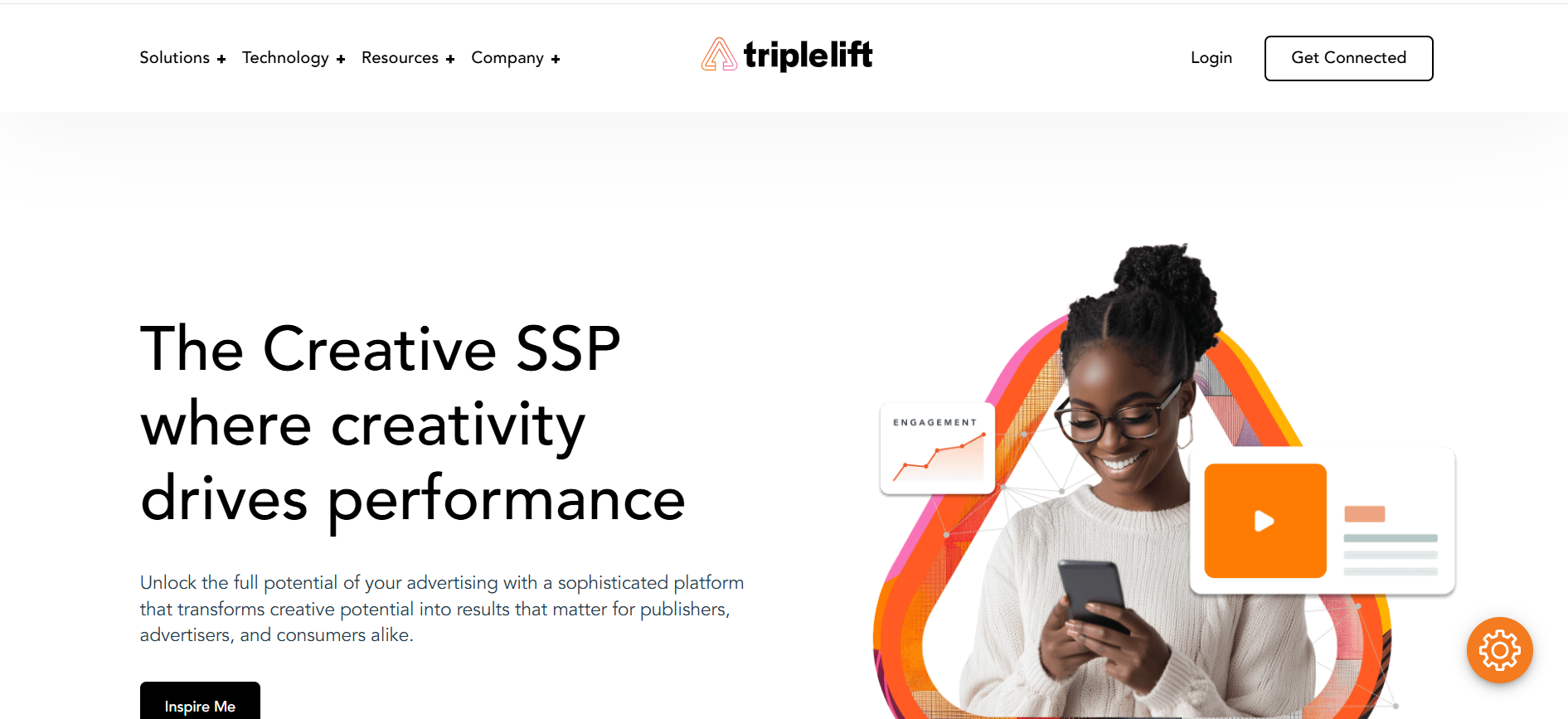
TripleLift is a leading contextual ad platform known for delivering native, display, and video ads that blend seamlessly with site content. Using computer vision and Natural Language Processing (NLP), TripleLift scans on-page elements to serve relevant, non-personalized ads. It emphasizes programmatic efficiency with direct access to premium demand, high viewability, and privacy-compliant solutions tailored for publishers and advertisers.
Features of TripleLift:
- Advanced contextual targeting via NLP and computer vision
- Native, display, and video ad formats
- Direct programmatic access and real-time bidding
- Dynamic creative rendering for seamless ad integration
- High viewability and user engagement focus
Reviews:
Publishers report excellent brand alignment and non-intrusive ad placements. The platform excels in native experiences, but performance varies based on layout and content volume.
Privacy Compliance:
TripleLift adheres to GDPR, CCPA, and other privacy regulations by offering cookie-free contextual targeting and user-consent frameworks.
Pros of TripleLift:
- Strong native ad performance
- Cookie-free contextual targeting
- Premium brand demand and high viewability
Cons of TripleLift:
- Requires well-structured content layouts
- May require optimization support for smaller publishers
Final Verdict:
TripleLift is a strong pick for publishers seeking high-performing, brand-safe native ads with a contextual and programmatic edge.
#8. Sovrn – Best for Contextual Ads with Publisher-Centric Tools

Sovrn is a publisher-first contextual ad network offering tools that go beyond monetization, including content analytics, audience insights, and commerce automation. Its contextual targeting capabilities allow for non-intrusive, relevant ad placements without relying on third-party cookies. Sovrn integrates seamlessly with header bidding and supports multiple ad formats including display, native, and affiliate commerce ads.
Features of Sovrn:
- Contextual targeting without user tracking
- Header bidding and programmatic demand support
- Display, native, and commerce ads (via //Commerce)
- Publisher insights and reporting tools
- Easy WordPress plugin and CMS integrations
Reviews:
Sovrn is appreciated by small-to-mid publishers for its transparency, fast payouts, and control over ad placements. Some note limited demand compared to larger networks.
Privacy Compliance:
Sovrn complies with GDPR, CCPA, and other data protection laws through privacy-first targeting models and opt-in frameworks.
Pros of Sovrn:
- Publisher-focused tools and insights
- Supports contextual commerce monetization
- Easy integration with existing ad tech
Cons of Sovrn:
- Smaller demand pool than Google AdSense
- Performance may vary with niche and geo-traffic
Final Verdict:
Ideal for publishers looking for contextual ad solutions with added tools for affiliate revenue, analytics, and ad stack optimization.
#9. Google Display Network – Best for Scalable, Keyword-Targeted Contextual Reach
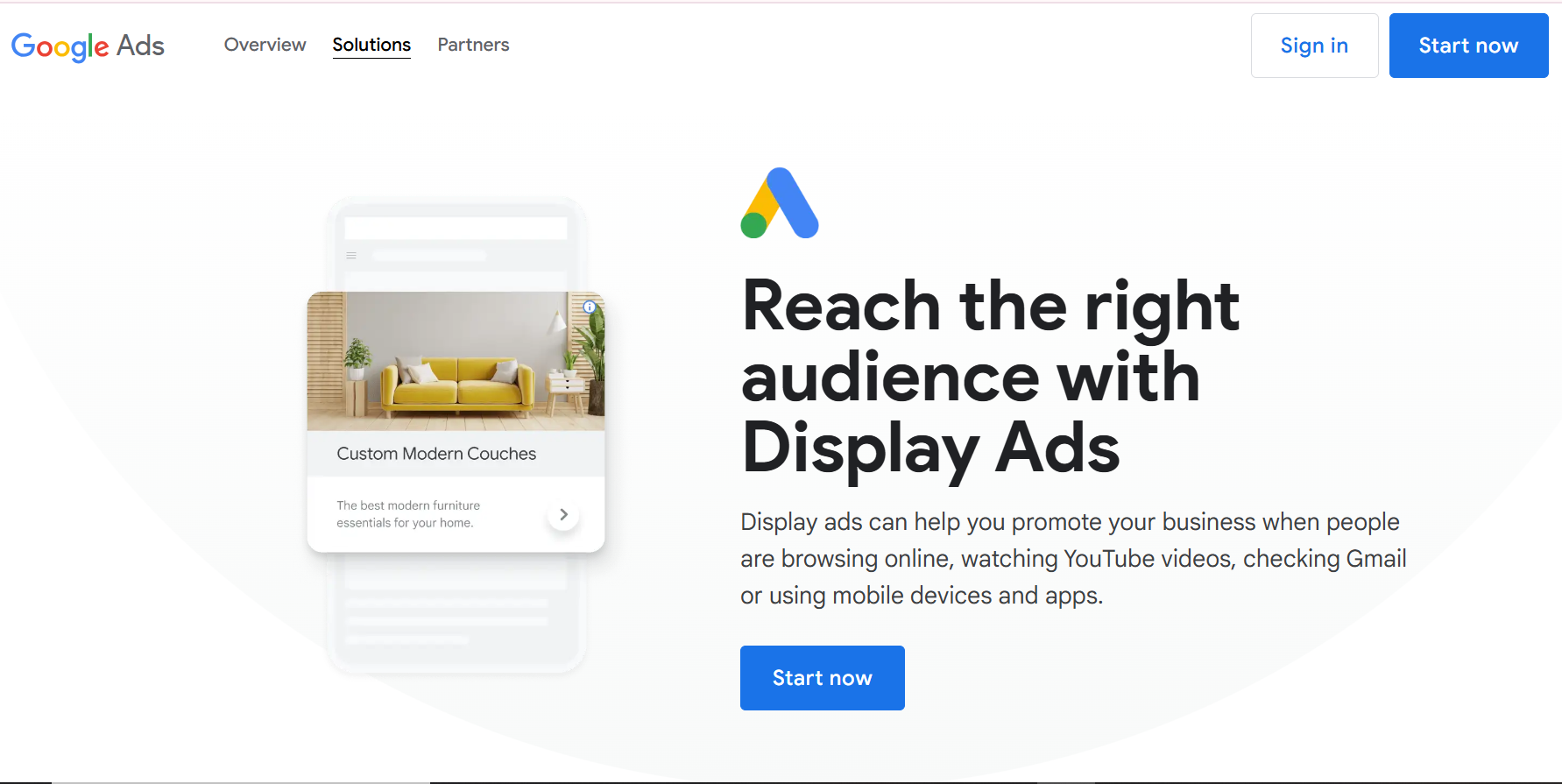
The Google Display Network (GDN) enables advertisers to place contextual ads across millions of websites, YouTube, and apps. It uses keyword targeting, placements, and topics to match ads with content, offering massive reach through contextual signals instead of personal data. Ideal for scalable, brand-safe campaigns across diverse content environments.
Features of Google Display Network:
- Contextual targeting via keywords, topics, and placements
- Access to millions of sites and apps
- Dynamic creative support (responsive display ads)
- Integration with Google Ads for unified control
- Automated bidding and audience exclusions
Reviews:
Advertisers praise its reach and control, while publishers benefit from consistent revenue—though optimization can require expertise.
Privacy Compliance:
Offers full support for GDPR and CCPA compliance using contextual signals and publisher-controlled targeting settings.
Pros of Google Display Network:
- Massive inventory and reach
- Strong keyword-based contextual options
- Powerful integration with Google Ads
Cons of Google Display Network:
- Less control for smaller publishers
- Requires ad campaign expertise to maximize value
Final Verdict:
Best suited for advertisers and larger publishers seeking scale, automation, and contextual precision across Google’s ecosystem.
#10. Criteo Contextual – Best for Privacy-Safe Contextual Ads in Commerce and Retail Media
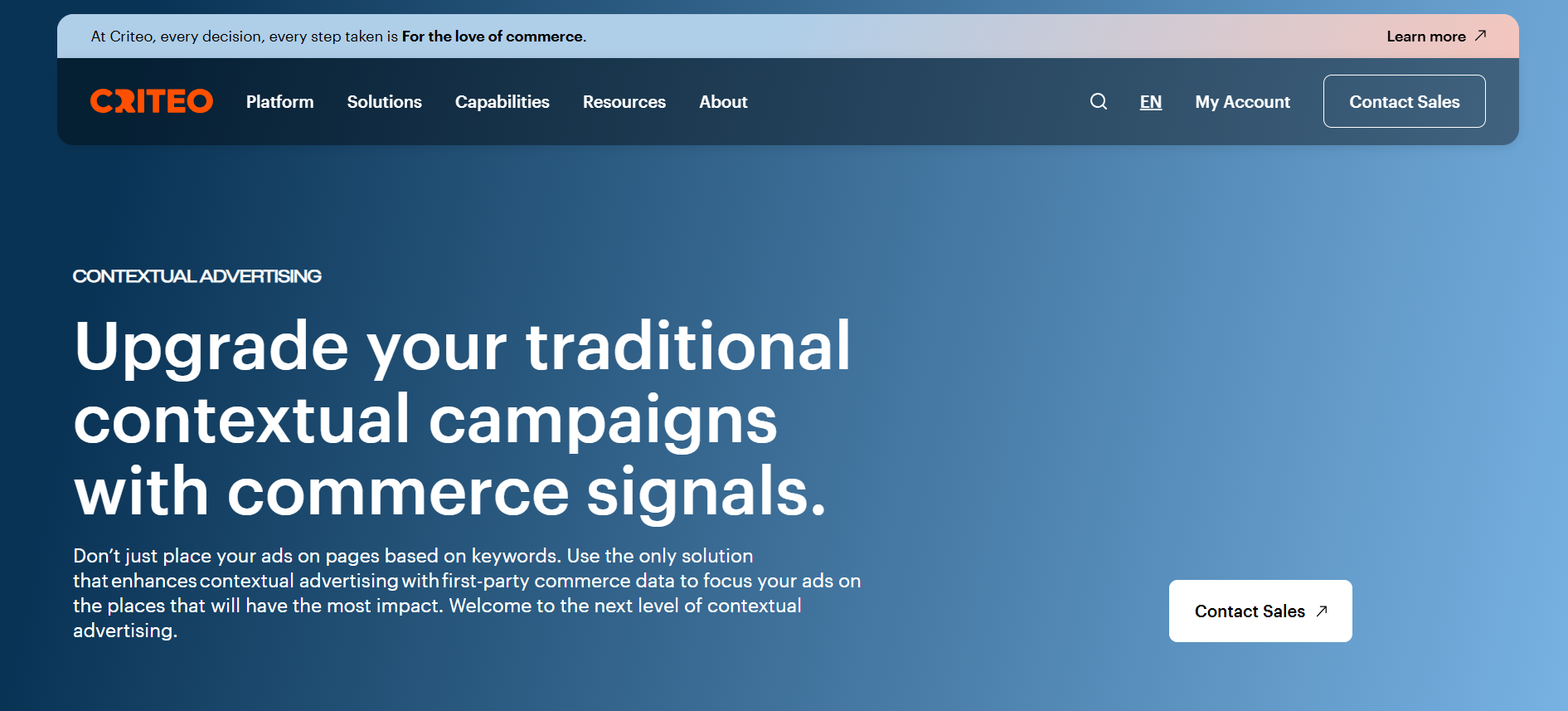
Criteo Contextual Advertising uses commerce signals and contextual insights to target ads without cookies, ideal for retail and eCommerce sectors. Leveraging first-party shopping intent and page-level analysis, it serves high-conversion ads while respecting user privacy. It’s a great fit for retail publishers and advertisers focused on performance in a cookieless environment.
Features of Criteo Contextual:
- Commerce-based contextual targeting
- AI-driven content and product matching
- Deep integration with retail media and marketplaces
- Cookieless, privacy-compliant by design
- Optimized for performance and product discovery
Reviews:
Criteo is often praised for driving ROAS and conversions in commerce-heavy campaigns, though setup may require technical alignment.
Privacy Compliance:
Built for a cookieless future, offering robust GDPR and CCPA compliance using contextual and first-party retail data.
Pros of Criteo Contextual:
- Retail-centric contextual engine
- High-performance in shopping and commerce niches
- Privacy-focused targeting approach
Cons of Criteo Contextual:
- Best suited for commerce-related content
- Integration can be complex for small sites
Final Verdict:
An excellent contextual platform for eCommerce-focused publishers and advertisers prioritizing privacy and ROI.
Frequently Asked Questions(FAQs)
Does the network use AI-powered semantic analysis for ad matching?
Yes, leading contextual ad networks use AI-powered semantic analysis and NLP (Natural Language Processing) to understand on-page meaning, tone, sentiment, and entities—ensuring highly relevant ad placements based on context rather than keywords alone.
Is the platform fully compliant with GDPR, CCPA, and other privacy laws?
Most modern contextual ad platforms are built with privacy compliance at their core, ensuring full adherence to GDPR, CCPA, LGPD, and other regional data regulations by eliminating reliance on third-party cookies and avoiding personal data processing.
What targeting methods are used instead of third-party cookies?
In place of cookies, contextual ad networks use page-level analysis, content classification, keyword density, sentiment, and first-party data from publishers to deliver ads based on the context and intent of the content not the user.
Does the network offer transparent reporting and performance metrics?
Absolutely. Reputable contextual platforms provide transparent, real-time dashboards with detailed metrics on CTR, viewability, engagement, placements, and revenue, enabling publishers and advertisers to optimize performance confidently.
